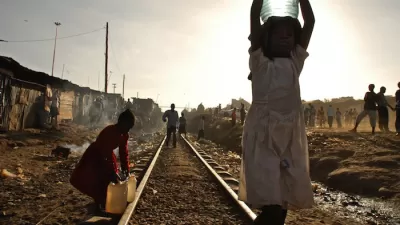A proposal for a vertical neighborhood in Delhi is long on height but short on insight, according to Greg Randolph of the American India Foundation. Is Delhi ‘poised to repeat the public housing mistakes of the West’?
“Like many neighborhoods in Delhi,” writes Randolph, Govindpuri “developed organically, outside the formal planning regime, and faces problems of infrastructure.” Poor sanitation, lack of access to potable water, and few standards for the structural safety of housing all suggest the need for redevelopment with community consultation, a standard adopted in 2009 by the national Ministry of Housing and Urban Poverty Alleviation.
A new proposal from the Delhi Development Authority, however, forgoes community consultation to envision a high-rise solution to slum redevelopment: 5,000 housing units ascending 17-stories, a vertical neighborhood disruptive of the long-established patterns of economic and social transaction occurring at the street-level in Govindpuri. Such a proposal, which Randolph cites as being environmentally and economically unsustainable to boot, is said to set a perilous precedent for slum redevelopment across India in ways that may sound similar to those familiar with the outdated urban renewal schemes undertaken in the West.
Rather than seek a comprehensive quick fix, Randolph urges Delhi and the DDA to become more immersed in solutions to slum redevelopment that “have evolved out of a decades-old dialectic between governments, communities, and designers,” and to let community consultation lead the way toward a “world-class” urban form.
FULL STORY: Delhi choosing high-rise over consultative planning despite national consensus on slums

Maui's Vacation Rental Debate Turns Ugly
Verbal attacks, misinformation campaigns and fistfights plague a high-stakes debate to convert thousands of vacation rentals into long-term housing.

Planetizen Federal Action Tracker
A weekly monitor of how Trump’s orders and actions are impacting planners and planning in America.

San Francisco Suspends Traffic Calming Amidst Record Deaths
Citing “a challenging fiscal landscape,” the city will cease the program on the heels of 42 traffic deaths, including 24 pedestrians.

Half of Post-Fire Altadena Home Sales Were to Corporations
Large investors are quietly buying up dozens of properties in Altadena, California, where a devastating wildfire destroyed more than 6,000 homes in January.

Opinion: What San Francisco’s Proposed ‘Family Zoning’ Could Really Mean
Mayor Lurie is using ‘family zoning’ to encourage denser development and upzoning — but could the concept actually foster community and more human-scale public spaces?

Jacksonville Launches First Autonomous Transit Shuttle in US
A fleet of 14 fully autonomous vehicles will serve a 3.5-mile downtown Jacksonville route with 12 stops.
Urban Design for Planners 1: Software Tools
This six-course series explores essential urban design concepts using open source software and equips planners with the tools they need to participate fully in the urban design process.
Planning for Universal Design
Learn the tools for implementing Universal Design in planning regulations.
Gallatin County Department of Planning & Community Development
Heyer Gruel & Associates PA
JM Goldson LLC
City of Camden Redevelopment Agency
City of Astoria
Transportation Research & Education Center (TREC) at Portland State University
Jefferson Parish Government
Camden Redevelopment Agency
City of Claremont



























